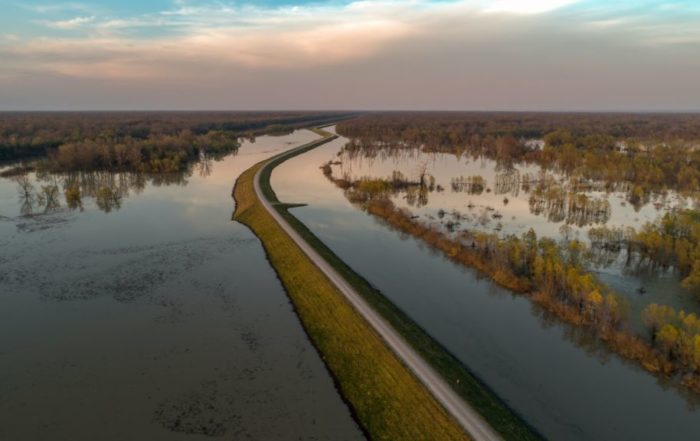The Dutch have been experts in flood control and preparedness for centuries. As sea levels rise worldwide, the Netherlands is on the frontlines of the battle against rising seas, and they’ve already begun sharing their techniques and technologies with flood-prone areas around the globe.
The masterful engineers behind the flood control infrastructure in the Netherlands pride themselves on a guiding philosophy that is the opposite of the approach taken in many other countries: work with nature, not against it. Putting this engineering philosophy into practice requires living with water, making room for it, and thinking about where water might go in the future.
As Wim Kuijken, former senior official for water control policy in the Netherlands, told the New York Times back in 2012, “The Dutch ‘way of thinking is completely different from the US,’ where disaster relief generally takes precedence over disaster avoidance. The US is excellent at disaster management,’ but ‘working to avoid disaster is completely different from working after a disaster.’”
Let’s take a look at the Dutch approach to disaster prevention and how their thinking about flooding is being applied to resilient design projects around the globe.
Why Dutch Engineers Excel at Flood Management Design
Although the Netherlands doesn’t experience hurricanes or typhoons, their long coast is frequently battered by powerful storms from the North Sea.
While flood control in the Netherlands was on their government’s agenda before 1953, that year marked a turning point in their efforts. A major flood submerged nine percent of Dutch farmland and took 8,000 lives.

The devastation inspired the Netherlands to embark on a massive flood protection project called the Delta Works – a series of dams, dikes, and other structures that took from 1959 to 1995 to complete. Throughout this effort, the Dutch developed innovative technologies and design thinking that have made them world experts in flood management.
By shortening their coastline and draining low lying areas, the Dutch have reduced their flood risk, improved their freshwater irrigation systems, and created a system of lakes that added recreational space near urban centers that’s both popular and functional.
Where You Can See the Dutch Approach to Flood Management in the US
Today, the Dutch understand that flood risk and climate change are inextricably linked, and their low lying country means they can’t afford to avoid the risks of inland flooding. It’s not a stretch to say that most American flood management projects have been inspired by the changing climate, and that local and state leaders alike look to the Dutch model for insights.

From Texas to the Carolinas, American states have taken up the challenge of improving their local infrastructure for flood water management by taking a page from the Hollanders. Three examples from the past decade that standout, two of which happen to be located in the same state:
- Manhattan, NY: The BIG U project in Manhattan was modeled after the Room for the River project in Nijmegen, Netherlands and executed as part of President Obama’s Rebuild by Design competition in the wake of Super Storm Sandy. By adding green and blue space, improving stormwater channels, and creating a buffer zone, city leaders hope this will help lower Manhattan weather future storms.
- Governors Island, NY: This island in the New York City Harbor was successfully redeveloped throughout the aughts into a tourist destination, much of which is run by the National Park Service. But many visitors may not know that the redesign was also intended to ensure the island’s longevity in the face of climate change. Its new topography has already passed one major test: in 2012, Governors Island emerged from Hurricane Sandy unscathed.
- New Orleans, LA. Following Hurricane Katrina, Dutch firm Waggonner & Ball held a three-day workshop to discuss ways to integrate water into the urban area to improve the city’s flood resilience. One of the notable results of this conversation was the Gentilly Resilience District’s water garden, updated stormwater network, and blue corridors, all of which reflect the Dutch influence.
While these three urban, coastal projects may seem like obvious targets for large-scale flood risk mitigation, many Americans underestimate their flood exposure, even those who live with water right outside their window.
If you don’t have flood insurance on your property, check your flood risk today.
Proactive Water Management Is Strong Flood Preparedness
Flood prevention isn’t just a Dutch challenge or an American infrastructure issue; it’s an issue that’s the subject of increased focus around the world. In St Petersburg, a port long plagued by seasonal floods, the Dutch techniques are easily transposed onto their long coastline.
On the other side of the mapJakarta, Indonesia, which was at one point a Dutch colony, briefly benefited from the canal systems the Hollanders brought with them. As Indonesian sea walls fail to stand up to the test of climate change, they’re once again looking to the Dutch for help developing long-term engineering solutions to their water problems.
While many of the places that most obviously benefit from Dutch engineering are coastal areas, flooding isn’t just coastal or related to hurricane activity. The thinking that guides these engineers can be applied to communities along the banks of the Mississippi River and in downtown Seattle.
If you’re not sure what your community would do in the face of a flood event, research your state’s response to increased flooding and consider your own flood preparedness efforts.









